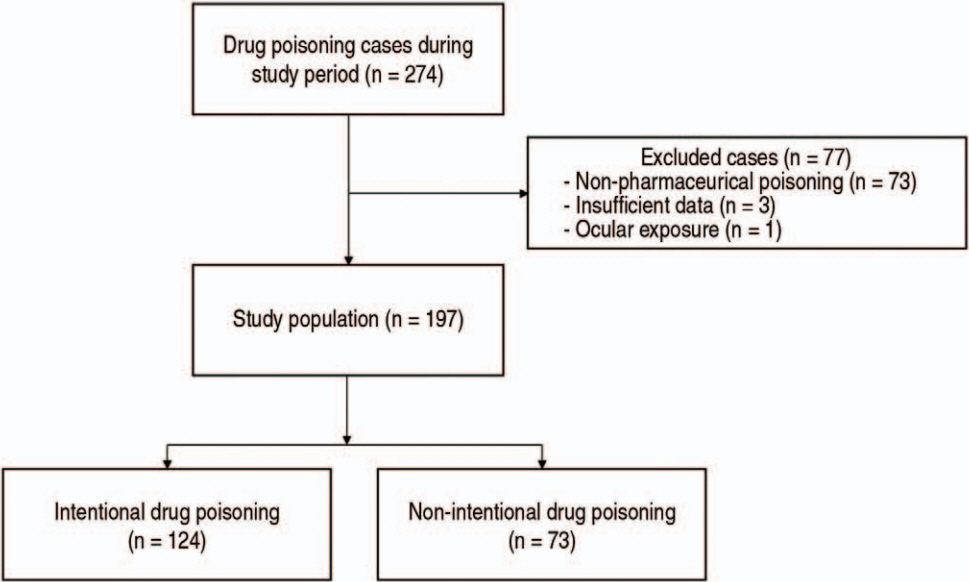Pediatr Emerg Med J.
2023 Jan;10(1):23-30. 10.22470/pemj.2022.00619.
Clinical features of children with drug poisoning in a single emergency department in Goyang, Korea
- Affiliations
-
- 1Department of Pediatrics, National Health Insurance Service Ilsan Hospital, Goyang, Republic of Korea
- KMID: 2538079
- DOI: http://doi.org/10.22470/pemj.2022.00619
Abstract
- Purpose
Pediatric drug poisoning is a frequent reason for emergency department (ED) visits. Considering the increasing number of mental illnesses in adolescents, it has become a serious public health problem. We aimed to investigate the drug poisoning in the ED.
Methods
We retrospectively analyzed children aged 1-17 years with diagnostic codes related to drug poisoning who visited the ED from January 1, 2010 through October 7, 2022. Exclusion criteria were non-pharmaceutical poisoning, insufficient data, and poisoning via respiratory, dermal or ocular route. Baseline characteristics, clinical manifestations, and outcomes of drug poisoning were analyzed in the study population, according to intention of poisoning and drug category.
Results
A total of 197 cases of 161 children were analyzed. Compared with non-intentional poisoning, intentional poisoning was associated a higher age, a longer time from ingestion to visit, and higher proportions of girls, antipyretics/analgesics or psychotropic drugs, symptoms related to the gastrointestinal, neurologic or cardiopulmonary systems (P = 0.034), psychiatric comorbidity, multiple drug ingestion, suicide attempt, decontamination (P = 0.017), the use of antidote, history of drug poisoning, and hospitalization (P = 0.004; all other Ps < 0.001). Acetaminophen, a representative of antipyretics/analgesics, was associated with a longer time from ingestion to visit and higher proportions of girls (P = 0.004), the presence of initial gastrointestinal symptoms, suicide attempt (P = 0.001), the use of antidote, and hospitalization (all other Ps < 0.001). Psychotropic drug was associated with higher proportions of psychiatric comorbidity (P < 0.001) and multiple drug ingestion (P = 0.012).
Conclusion
This study will enable pediatricians or emergency physicians to obtain an overview of the management of drug poisoning in EDs.
Keyword
Figure
Reference
-
References
1. Halhalli HC, Uslu T. Evaluation of pediatric patients admitted to the emergency department due to drug intoxication. Cureus. 2021; 13:e13366.2. KOICD. Korean Classification of Disease [Internet]. Daejeon (Korea): KOICD;c2020 [cited 2022 Nov 20]. Available from: https://www.koicd.kr/kcd/kcd.do?degree=08. Korean.3. KOICD. S00-T98 XIX. Damage, poisoning, and certain other consequences of external causes [Internet]. Daejeon (Korea): KOICD;c2020 [cited 2022 Nov 20]. Available from: https://www.koicd.kr/stt/statDisease.do#. Korean.4. Korean Statistical Information System. Number of deaths by causes of death (104 items)/gender/age (5 years old), mortality rate [Internet]. Daejeon (Korea): Statistics Korea;Available from: https://kosis.kr/statHtml/statHtml.do?orgId=101&tblId=DT_1B34E01&checkFlag=N. Korean.5. Lee MH, Jang JH, Cho JS, Choi WS, Choi JY. Clinical features of adolescents with suicide attempt and the factors associated with their outcomes: poisoning versus non-poisoning. Pediatr Emerg Med J. 2020; 7:85–93. Korean.6. Alander SW, Dowd MD, Bratton SL, Kearns GL. Pediatric acetaminophen overdose: risk factors associated with hepatocellular injury. Arch Pediatr Adolesc Med. 2000; 154:346–50.7. Prescott LF, Park J, Ballantyne A, Adriaenssens P, Proudfoot AT. Treatment of paracetamol (acetaminophen) poisoning with N-acetylcysteine. Lancet. 1977; 2:432–4.8. An YJ, Paek SH, Kim OJ, Kim JA, Kwon JH, Kim MJ. Gender differences in characteristics of adolescents with suicide attempt at the emergency department. Pediatr Emerg Med J. 2020; 7:120–6. Korean.9. Gokalp G. Evaluation of poisoning cases admitted to pediatric emergency department. Int J Pediatr Adolesc Med. 2019; 6:109–14.10. Rasheed EA, Elmahdy N, Shalaby E, Karoube HS, Badawy SM. A study of pharmaceutical drugs poisoning cases admitted to the National Poisoning Center, Kasralainy Teaching Hospital in Cairo. Eurasian J Emerg Med. 2020; 19:10–5.11. Zyoud SH, Awang R, Sulaiman SA, Al-Jabi SW. Association between gastrointestinal manifestations following acetaminophen poisoning and outcome in 291 acetaminophen poisoning patients. Pharmacoepidemiol Drug Saf. 2010; 19:511–7.12. Smilkstein MJ, Knapp GL, Kulig KW, Rumack BH. Efficacy of oral N-acetylcysteine in the treatment of acetaminophen overdose. Analysis of the national multicenter study (1976 to 1985). N Engl J Med. 1988; 319:1557–62.13. Keays R, Harrison PM, Wendon JA, Forbes A, Gove C, Alexander GJ, et al. Intravenous acetylcysteine in paracetamol induced fulminant hepatic failure: a prospective controlled trial. BMJ. 1991; 303:1026–9.14. Tucker JR. Late-presenting acute acetaminophen toxicity and the role of N-acetylcysteine. Pediatr Emerg Care. 1998; 14:424–6.15. Barbey JT, Roose SP. SSRI safety in overdose. J Clin Psychiatry. 1998; 59 Suppl(15):42–8.16. Meli M, Rauber-Lüthy C, Hoffmann-Walbeck P, Reinecke HJ, Prasa D, Stedtler U, et al. Atypical antipsychotic poisoning in young children: a multicentre analysis of poisons centres data. Eur J Pediatr. 2014; 173:743–50.17. Kang M, Galuska MA, Ghassemzadeh S. Benzodiazepine toxicity [updated 2022 Jun 27]. In: StatPearls [Internet]. Treasure Island (FL): StatPearls Publishing;2022. [cited 2022 Aug 14]. Available from: https://www.ncbi.nlm.nih.gov/books/NBK482238/.18. Hori S, Kinoshita K. Clinical characteristics of patients who overdose on multiple psychotropic drugs in Tokyo. J Toxicol Sci. 2016; 41:765–73.
- Full Text Links
- Actions
-
Cited
- CITED
-
- Close
- Share
- Similar articles
-
- Retrospective Analysis on the Clinical Differences of Children and Adolescents Treated for Acute Pediatric Poisoning in an Emergency Department?
- Clinical features of adolescents with suicide attempt and the factors associated with their outcomes: poisoning versus non-poisoning
- Clinical Analysis of Acute Drug Poisoning Victims by Intentional Poisoning
- Pharmaceutical Drug Poisoning after Deregulation of Over the Counter Drug Sales: Emergency Department Based In-depth Injury Surveillance
- Clinical characteristics and cholinesterase levels in childrenwith carbofuran poisoning


